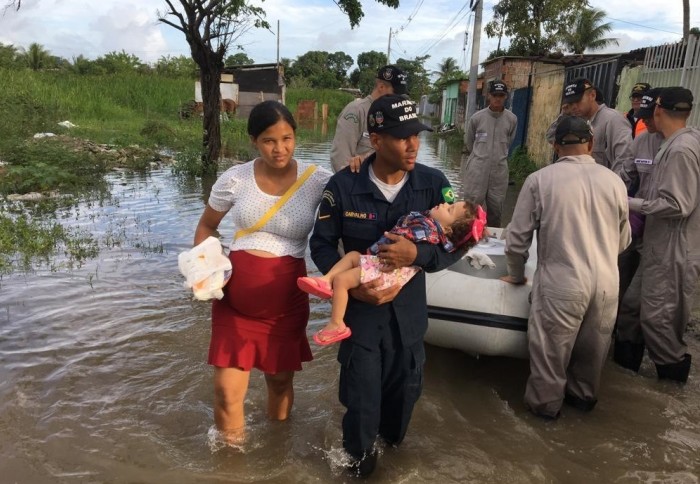
Operação Chuvas 2022, in Pernambuco, Brazil

New study shows the devastating floods in the Northeast region of Brazil were made more likely and heavier by human-caused climate change.
In late May 2022, the states of Rio Grande do Norte, Paraiba, Pernambuco, Alagoas and Sergipe experienced catastrophic floods and landslides following exceptionally heavy rainfall. In less than 24 hours, some regions experienced about 70% of the total amount of rainfall expected for the whole month. The resulting landslides and flash floods led to 133 deaths and the displacement of more than 25,000 people.
“Once again we see how the combination of climate change-fuelled extreme weather events and high vulnerability in the population can lead to dramatic consequences." Dr Friederike Otto
This study is the latest ‘rapid attribution’ analysis carried out by an international team of over 20 leading climate scientists from the World Weather Attribution group. It also found that the extreme rain caused more damage because many people were living in low-lying flood-prone areas and on steep hillsides at risk of landslides.
“Once again we see how the combination of climate change-fuelled extreme weather events and high vulnerability in the population can lead to dramatic consequences,” said co-author Dr Friederike (Fredi) Otto, Senior Lecturer at the Grantham Institute – Climate Change and the Environment at Imperial College London. “Governments in Brazil and around the world need to put more effort in cutting global carbon emissions fast but also implementing strategies to reduce risks from climate impacts locally”.
Vulnerable communities at risk from climate impacts
"Our findings underline the importance of prioritising adaptation of vulnerable communities to weather and climate extremes in the face of climate change." Dr Mariam Zachariah
Eastern Northeast Brazil is the region of the country with the highest proportion of the population living in poverty, making it particularly vulnerable to changing intensity and likelihoods of extreme weather events.
Reducing the risk exposure of this population, as well as improving heavy rainfall forecasts and implementing rapid prevention actions, can help communities become more resilient to extreme events in the future.
"Together with evidence from other global regions, our findings underline the importance of prioritising adaptation of vulnerable communities to weather and climate extremes in the face of climate change," said lead author Dr Mariam Zachariah, Research Associate at the Grantham Institute.
Dr Alexandre Köberle, Advanced Research Fellow at the Grantham Institute and co-author, agreed: “As cities grow, planners need to find ways to decrease people’s exposure to extreme weather events and to increase resilience. An effective urban design can greatly reduce the impacts of heavy rainfall and save lives and infrastructure, as can improving the effectiveness of early warning systems that lead to rapid action ahead of extreme events. These are powerful tools to adapt to climate change and its associated impacts”.
Evaluating the role of climate change in extreme weather
To evaluate the influence of climate change caused by human activities, such as burning fossil fuels and deforestation, on both the chances of this extreme rainfall happening and its intensity, the scientists analysed weather data and computer simulations to compare the climate as it is today, after about 1.2°C of global warming since the late 1800s, with the climate of the past, following peer-reviewed methods.
They looked at rainfall levels over 7-day and 15-day periods in the worst-affected region, an area spanning the coastal areas of the states of Rio Grande do Norte, Paraiba, Pernambuco and Alagoas. They found that, although it is still a rare event in today’s climate with only a 1-in-500 to 1-in-1000 chance of happening in a single year, human-caused climate change made the rainfall more likely.
The rainfall was also about 20% heavier than it would have been in a 1.2°C colder world. It is clear, the scientists concluded, that at least part of this increase is due to human-caused climate change. Limitations with climate models, which are not able to accurately simulate events in the region, means that it is currently not possible to quantify the exact change in magnitude due to climate change.
The results are consistent with scientific understanding of how climate change, caused by human greenhouse gas emissions, influences heavy rainfall. As the atmosphere becomes warmer, it can hold more water, increasing the risk of downpours. With further greenhouse gas emissions and continued temperature increases, heavy rainfall episodes will become even more common and intense.
Download the full study: “Climate change increased heavy rainfall, hitting vulnerable communities in Eastern Northeast Brazil” (PDF, 31 pages, 6.6MB)
[Image credit: CC BY-SA 2.0 <https://creativecommons.org/licenses/by-sa/2.0/> via Wikimedia Commons]
Supporters

Article text (excluding photos or graphics) © Imperial College London.
Photos and graphics subject to third party copyright used with permission or © Imperial College London.
Reporter
Lottie Butler
The Grantham Institute for Climate Change


